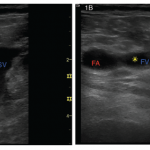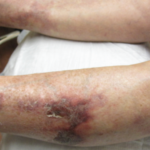To manage ongoing warfarin therapy, patient self-testing—when the patient performs the INR at home but contacts the healthcare provider for dose adjustment—and self-monitoring—when patients are taught to adjust their own warfarin—are used increasingly in the outpatient setting. Although patient involvement may have the potential to hit the therapeutic range, and studies have shown that time in therapeutic range goes up the more frequently you test the INR, Dr. Ortel has concerns about the medicolegal implications of this monitoring method.
Weighing the Guidance
Stephan Moll, MD, associate professor of medicine in the Division of Hematology/Oncology at the University of North Carolina School of Medicine in Chapel Hill, personalized his advice to the meeting participants regarding deep vein thrombosis (DVT) prophylaxis. “If I was medically sick in your hospital or had hip or knee replacement, I would want to receive either low-molecular-weight heparin [LMWH] or fondaparinux. I would not want just aspirin,” he asserted. This strategy is in alignment with the American College of Chest Physicians’ (ACCP’s) June 2008 clinical practice guidelines for antithrombotic and thrombolytic therapy.2 Dr. Moll culled information from the ACCP and other clinical practice guidelines and quizzed his audience with clinical scenarios to explicate DVT/pulmonary embolism (PE) prophylaxis as well as the management of venous and arterial thromboembolic risks.
Dr. Moll presented numerous scenarios in which rheumatologists may typically face decisions about effective DVT prophylaxis, an issue that is currently being targeted with recent initiatives promulgated by the Joint Commission for the Accreditation for Health Care Organizations, the U.S. Surgeon General, and the Centers for Medicare and Medicaid Services’ reimbursement rules. After total hip or knee replacement, the ACCP guideline advises use of LMWH, fondaparinux, or warfarin with a target INR of 2 to 3 for at least 10 days and as long as five weeks after the surgery.
Dr. Moll cautioned his audience to be aware of discrepant opinions between different specialties. For instance, the American Academy of Orthopedic Surgeons would add aspirin to ACCP’s list of prophylactic strategies for postoperative DVT prophylaxis. “Unfortunately, patients are caught in between two different opinions,” he pointed out. “The surgeons don’t want the patients to bleed; the internal medicine folks don’t want the patients to clot.”
Rheumatologists should communicate with orthopedic surgeons at their institutions about their recommendations and try to achieve consensus about what the patient should get after surgery, Dr. Moll said. He recommends that patients with hypercoagulable states be treated with LMWH, fondaparinux, or warfarin.



